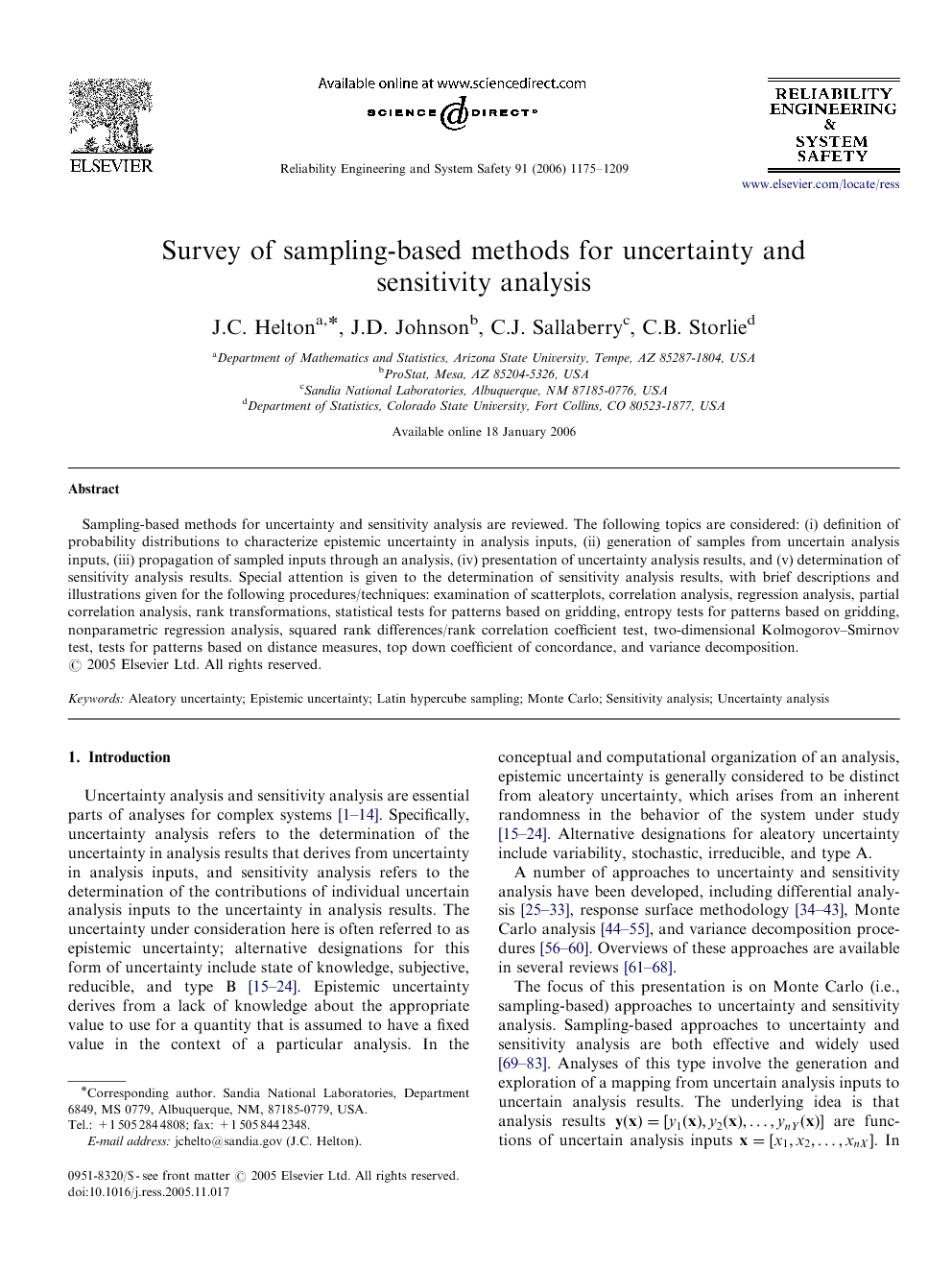Uncertainty analysis and sensitivity analysis are essential parts of analyses for complex systems [1], [2], [3], [4], [5], [6], [7], [8], [9], [10], [11], [12], [13] and [14]. Specifically, uncertainty analysis refers to the determination of the uncertainty in analysis results that derives from uncertainty in analysis inputs, and sensitivity analysis refers to the determination of the contributions of individual uncertain analysis inputs to the uncertainty in analysis results. The uncertainty under consideration here is often referred to as epistemic uncertainty; alternative designations for this form of uncertainty include state of knowledge, subjective, reducible, and type B [15], [16], [17], [18], [19], [20], [21], [22], [23] and [24]. Epistemic uncertainty derives from a lack of knowledge about the appropriate value to use for a quantity that is assumed to have a fixed value in the context of a particular analysis. In the conceptual and computational organization of an analysis, epistemic uncertainty is generally considered to be distinct from aleatory uncertainty, which arises from an inherent randomness in the behavior of the system under study [15], [16], [17], [18], [19], [20], [21], [22], [23] and [24]. Alternative designations for aleatory uncertainty include variability, stochastic, irreducible, and type A.
A number of approaches to uncertainty and sensitivity analysis have been developed, including differential analysis [25], [26], [27], [28], [29], [30], [31], [32] and [33], response surface methodology [34], [35], [36], [37], [38], [39], [40], [41], [42] and [43], Monte Carlo analysis [44], [45], [46], [47], [48], [49], [50], [51], [52], [53], [54] and [55], and variance decomposition procedures [56], [57], [58], [59] and [60]. Overviews of these approaches are available in several reviews [61], [62], [63], [64], [65], [66], [67] and [68].
The focus of this presentation is on Monte Carlo (i.e., sampling-based) approaches to uncertainty and sensitivity analysis. Sampling-based approaches to uncertainty and sensitivity analysis are both effective and widely used [69], [70], [71], [72], [73], [74], [75], [76], [77], [78], [79], [80], [81], [82] and [83]. Analyses of this type involve the generation and exploration of a mapping from uncertain analysis inputs to uncertain analysis results. The underlying idea is that analysis results y(x)=[y1(x),y2(x),…,ynY(x)]y(x)=[y1(x),y2(x),…,ynY(x)] are functions of uncertain analysis inputs x=[x1,x2,…,xnX]x=[x1,x2,…,xnX]. In turn, uncertainty in x results in a corresponding uncertainty in y(x). This leads to two questions: (i) what is the uncertainty in y(x) given the uncertainty in x? and (ii) how important are the individual elements of x with respect to the uncertainty in y(x)? The goal of uncertainty analysis is to answer the first question, and the goal of sensitivity analysis is to answer the second question. In practice, the implementation of an uncertainty analysis and the implementation of a sensitivity analysis are very closely connected on both a conceptual and a computational level.
The following sections summarize and illustrate the five basic components that underlie the implementation of a sampling-based uncertainty and sensitivity analysis: (i) definition of distributions D 1, D 2,…,DnX that characterize the epistemic uncertainty in the elements x 1, x 2,…,xnX of x ( Section 2), (ii) generation of a sample x1, x2,…,xnS from the x's in consistency with the distributions D 1, D 2,…,DnX ( Section 3), (iii) propagation of the sample through the analysis to produce a mapping [xi , y(xi )], i=1,2,…,nSi=1,2,…,nS, from analysis inputs to analysis results ( Section 4), (iv) presentation of uncertainty analysis results (i.e., approximations to the distributions of the elements of y constructed from the corresponding elements of y(xi ), i=1,2,…,nSi=1,2,…,nS) ( Section 5), and (v) determination of sensitivity analysis results (i.e., exploration of the mapping [xi , y(xi )], i=1,2,…,nSi=1,2,…,nS) ( Section 6). The presentation then ends with a concluding summary ( Section 7).
Only probabilistic characterizations of uncertainty are considered in this presentation. Alternative uncertainty representations (e.g., evidence theory, possibility theory, fuzzy set theory, interval analysis) are active areas of research [84], [85], [86], [87], [88], [89], [90], [91] and [92] but are outside the intended scope of this presentation.


